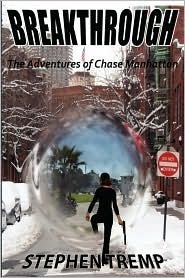Monday Moods--Adventurous & . . . still Crafty

"BREAKTHROUGH: “THE ADVENTURES OF CHASE MANHATTAN" BY Stephen Tremp, will be free for (2) days on Amazon June 18th - June 19th. Be sure to download your copy! You can visit Stephen’s Website Breakthrough Blogs for more synopses and reviews.
This looks adventurous, doesn't it? Thanks for the visit, Stephen and good luck on your book.
***
Last week I returned to the CRAFT of writing, specifically DESCRIPTION. I love description in a story when it's done right and creates the reality of the place and the people in it. But getting it right isn't easy. It takes a lot of practice and, I believe, a lot of reading.
One element in description that I love is figurative language: the simile and metaphor. The biggest mistake I've made and that others also make is falling into the lazy cliché trap. "He fought like a madman." OR "Her eyes were deep blue pools."
Here's some description that fell into that trap and, therefore, doesn't work--at least for me. I'll let you decide how you react to it. It will be interesting to find out if you agree or disagree with me.
He stood dead center in the field and listened to the mixed warbling of birdsong and the rustling sound of a breeze blowing through the tree tops. In the distance he heard the hum of traffic coming from the busy highway.
Whoever created the phrase "dead center" did so a long time ago. Any freshness vanished before I started reading books. So is there another way to say someone has arrived in the middle of something? How about, "He'd come half-way across the field." Not terribly exciting, but all description doesn't have to be exciting; it only has to put the reader into the place with your character(s), right?
"Listened to" as it's used here is one of those overused/abused filter words that I find dotting my first drafts all the time. I hate them, but I can't seem to avoid them when I'm setting down a story. Thank goodness someone invented REVISION and gave writers a delete key. Take out those filter words and free your prose.
I always like a bit of detail in my description, and I don't like having to figure out too much of the setting or where the character is located in that setting. In the example above, we have a field, but then are there trees in this field? It seems as if there are, so why not give that bit to us? And why not give us the kind of tree. That's easy and it changes the feel of the setting.
Why do birds have to "warble" and breezes "rustle" through tree tops? Couldn't birds sounds come to the page differently? Could they just be birdsongs? Could leaves in a breeze just be that? I think letting the reader fill in what they sound like is a better choice here.
So now that I've deconstructed this bit of description, it's only fair that I put it back together. This is one way I'd do it.
He'd come half-way across the field and stopped under the shade of an oak. The muffled drone of traffic coming from the highway was overlaid with birdsong and the fingers of a breeze playing through the tree top.
Okay, your turn. Maybe you'd like to DECONSTRUCT my version. There's more than one way to build a good descriptive moment.
Sliding on the Edge, C. Lee McKenzie, WestSide Books, Spring '09
The Princess of Las Pulgas, WestSide Books, Fall '10
The First Time, Fall '11 (Anthology story: Premeditated Cat)
Alligators Overhead, Outskirts Press, Fall '12
Published on June 18, 2012 05:00
No comments have been added yet.



